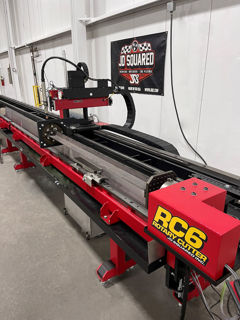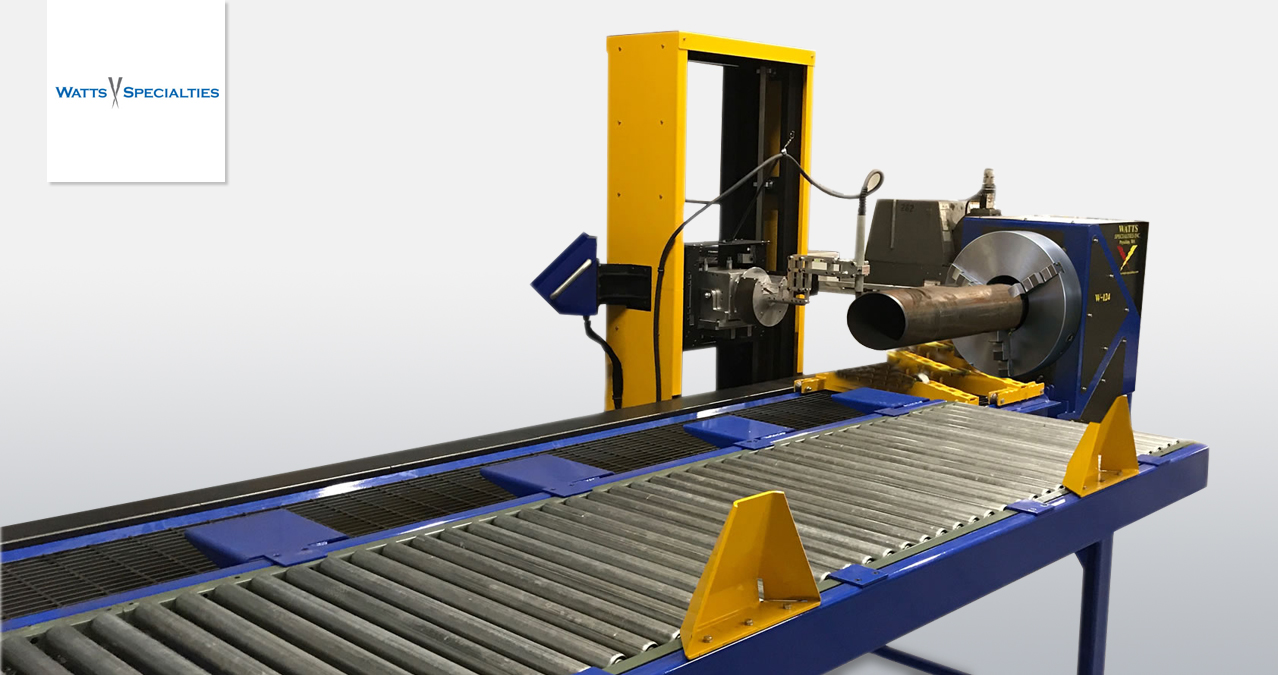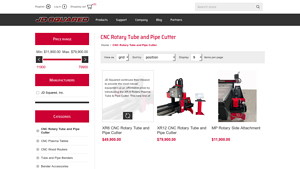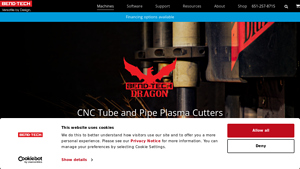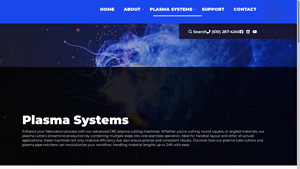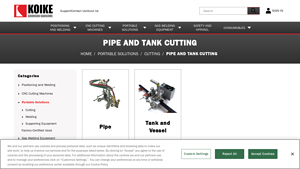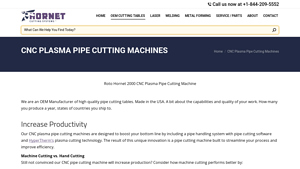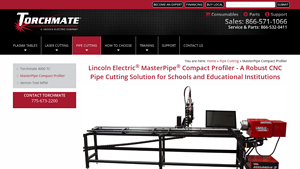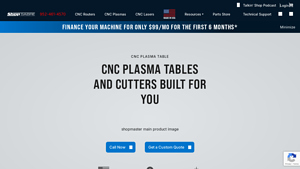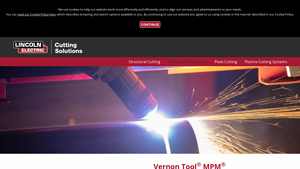Pipe Plasma Cutting Machines Guide: Type, Cost, Top List…
Introduction: Navigating the Global Market for pipe plasma cutting machines
Navigating the global market for pipe plasma cutting machines presents unique challenges for international B2B buyers, particularly when sourcing equipment that meets diverse operational needs across various industries. As businesses in regions such as Africa, South America, the Middle East, and Europe strive for efficiency, precision, and cost-effectiveness, understanding the intricacies of pipe plasma cutting technology becomes essential. This guide serves as a comprehensive resource, exploring the different types of machines available, their applications in industries ranging from automotive to construction, and critical factors for supplier vetting.
In this guide, you will find detailed insights on the latest advancements in pipe plasma cutting technology, along with practical advice on evaluating features such as cutting capabilities, material compatibility, and software integration. Additionally, we will delve into cost considerations, financing options, and maintenance practices to ensure you make informed purchasing decisions that align with your business goals.
By leveraging this resource, B2B buyers can navigate the complexities of the global market with confidence, selecting the right pipe plasma cutting machines that enhance productivity and drive competitive advantage in their respective markets. Whether you are in Brazil looking to optimize your fabrication processes or in Saudi Arabia seeking reliable cutting solutions, this guide empowers you to make strategic investments that meet your operational demands.
Understanding pipe plasma cutting machines Types and Variations
| Type Name | Key Distinguishing Features | Primary B2B Applications | Brief Pros & Cons for Buyers |
|---|---|---|---|
| CNC Rotary Tube and Pipe Cutter | Versatile for cutting various shapes and materials; rotary motion for precision | Automotive, construction, metal fabrication | Pros: High accuracy, multi-material capability; Cons: Higher initial investment. |
| Round-Only CNC Plasma Cutter | Specialized for round pipes; minimal operation learning curve | Plumbing, HVAC, exhaust systems | Pros: Easy to operate, cost-effective; Cons: Limited to round materials only. |
| Multi-Purpose CNC Plasma Tables | Adaptable for various cutting tasks; supports rotary attachments | General fabrication, artistic metalwork | Pros: Versatility, space-saving; Cons: May require additional attachments for full functionality. |
| Production-Level CNC Cutters | High-speed cutting with smart nesting; integrated marking systems | Large-scale manufacturing, custom fabrication | Pros: Increases production efficiency; Cons: May require skilled operators for setup. |
| Portable Plasma Cutting Systems | Lightweight, easy to transport; suitable for fieldwork | Construction, maintenance, repair | Pros: Flexibility in location; Cons: Limited cutting capacity compared to stationary models. |
What Are the Key Characteristics of CNC Rotary Tube and Pipe Cutters?
CNC Rotary Tube and Pipe Cutters are designed for high precision and versatility, allowing users to cut various shapes such as round, square, and rectangular pipes. These machines often feature advanced CNC capabilities, enabling intricate designs and efficient workflows. They are particularly suitable for industries like automotive and construction, where precision and material diversity are crucial. B2B buyers should consider the initial investment and the machine’s adaptability to different materials, as these factors significantly impact operational efficiency.
How Do Round-Only CNC Plasma Cutters Serve Specific Industries?
Round-Only CNC Plasma Cutters are tailored for cutting cylindrical materials, making them ideal for plumbing, HVAC, and exhaust system applications. They offer a minimal learning curve for operators, which can be a significant advantage for businesses looking to train staff quickly. While these machines are cost-effective and easy to operate, buyers must note their limitations in cutting only round materials, which could restrict their application scope in certain industries.
What Advantages Do Multi-Purpose CNC Plasma Tables Offer?
Multi-Purpose CNC Plasma Tables stand out for their adaptability, allowing users to perform various cutting tasks beyond just pipe cutting. By incorporating rotary attachments, these machines can cut complex shapes and designs, making them suitable for general fabrication and artistic projects. B2B buyers should consider the space-saving nature of these systems, although they may need to invest in additional attachments for full functionality, which could increase overall costs.
Why Choose Production-Level CNC Cutters for Large-Scale Manufacturing?
Production-Level CNC Cutters are engineered for high-speed operations, often equipped with smart nesting features and integrated marking systems to enhance productivity. These machines are essential for large-scale manufacturing and custom fabrication, where efficiency and accuracy are paramount. However, they may require skilled operators for setup and operation, which can present a challenge for some businesses. Buyers should weigh the benefits of increased production against the potential need for specialized training.
What Are the Benefits of Portable Plasma Cutting Systems for On-Site Work?
Portable Plasma Cutting Systems are designed for flexibility and ease of transport, making them ideal for construction sites and maintenance tasks. Their lightweight design allows for on-the-go operations, which can be a significant advantage in industries that require fieldwork. However, these systems typically have limited cutting capacity compared to stationary models, which buyers should consider based on their specific operational needs.
Key Industrial Applications of pipe plasma cutting machines
| Industry/Sector | Specific Application of pipe plasma cutting machines | Value/Benefit for the Business | Key Sourcing Considerations for this Application |
|---|---|---|---|
| Manufacturing | Cutting and fabricating structural components | Reduces material waste and enhances precision in production | Machine compatibility with existing setups and materials |
| Oil & Gas | Creating piping systems and components | Increases operational efficiency and reduces lead times | Compliance with industry standards and certifications |
| Construction | Fabricating handrails, railings, and supports | Enhances safety features and customizability in designs | Durability of machinery and after-sales support |
| Automotive | Producing exhaust systems and frame components | Improves throughput and lowers production costs | Versatility in cutting various materials and thicknesses |
| Food & Beverage | Manufacturing piping for processing equipment | Ensures hygiene and compliance with industry regulations | Ability to cut stainless steel and other food-safe materials |
In the manufacturing sector, pipe plasma cutting machines are pivotal for cutting and fabricating structural components such as frames and supports. These machines offer high precision, which significantly reduces material waste and ensures that components fit perfectly during assembly. International buyers must consider the compatibility of the machines with their existing production setups and the types of materials they typically use.
Within the oil and gas industry, these machines are essential for creating intricate piping systems and components. The efficiency gained through plasma cutting leads to quicker turnaround times and streamlined operations, which is crucial in this fast-paced sector. Buyers should pay attention to compliance with industry standards and certifications that ensure safety and reliability in high-pressure environments.
In construction, the application of pipe plasma cutting machines extends to fabricating handrails, railings, and various support structures. This not only enhances the safety features of buildings but also allows for custom designs to meet specific project requirements. When sourcing, businesses should prioritize the durability of the machinery and the availability of after-sales support to minimize downtime.
The automotive industry benefits from these machines in the production of exhaust systems and frame components. The ability to produce parts with high accuracy helps improve throughput while significantly reducing production costs. For international buyers, it is essential to ensure that the machines can handle various materials and thicknesses, as this versatility can impact overall production capabilities.
Lastly, in the food and beverage sector, pipe plasma cutting machines are used to manufacture piping for processing equipment. This application is critical for ensuring hygiene and compliance with strict industry regulations. Buyers should focus on the machine’s ability to cut stainless steel and other food-safe materials, as well as the technology’s capability to meet cleanliness standards during production.
3 Common User Pain Points for ‘pipe plasma cutting machines’ & Their Solutions
Scenario 1: Difficulty in Achieving Precise Cuts for Complex Designs
The Problem: Many B2B buyers in industries such as automotive and construction face challenges with achieving precise cuts when working with intricate designs on pipes and tubes. This is particularly problematic when the projects demand high accuracy, as even minor errors can lead to significant material waste and increased labor costs. Buyers often find that traditional cutting methods fall short, resulting in the need for extensive rework or even complete part replacements, which can delay project timelines and affect overall profitability.
The Solution: To overcome this challenge, investing in advanced CNC plasma cutting machines specifically designed for pipe and tube cutting is essential. Look for machines that incorporate features like smart nesting capabilities and automated marking systems to enhance cutting precision. When sourcing these machines, prioritize those equipped with advanced software that can interpret CAD/CAM designs seamlessly. Additionally, ensure that your team is trained on using the software effectively, as proper programming is crucial for achieving the desired accuracy. Regular maintenance and calibration of the plasma cutting machine will also help maintain cutting quality over time, minimizing the risk of errors during operation.
Scenario 2: High Operating Costs Due to Inefficiency
The Problem: B2B buyers often encounter high operational costs linked to inefficient cutting processes. Many companies rely on outsourced cutting services or outdated equipment that cannot keep up with the demands of modern production schedules. This inefficiency not only leads to inflated costs but also hampers a company’s ability to meet client deadlines, ultimately affecting customer satisfaction and competitive edge in the market.
The Solution: To tackle this issue, businesses should consider investing in in-house pipe plasma cutting machines that can streamline production processes. By selecting machines that offer high-speed cutting and versatile capabilities—such as the ability to cut various materials and shapes—companies can reduce reliance on external suppliers. Look for machines that feature integrated systems for automatic tool height adjustment and collision detection to enhance productivity and minimize downtime. Additionally, explore financing options or leasing arrangements to mitigate the initial investment costs, allowing for a gradual transition to a more efficient cutting operation that pays for itself over time.
Scenario 3: Challenges with Material Versatility and Compatibility
The Problem: Another significant pain point for B2B buyers is the limited versatility of cutting machines regarding material compatibility. In industries like construction and manufacturing, there’s often a need to work with various materials, including stainless steel, aluminum, and plastics. Buyers frequently struggle with machines that cannot effectively handle different materials, leading to delays and additional costs associated with acquiring multiple cutting systems.
The Solution: When selecting a pipe plasma cutting machine, prioritize models that boast a wide range of material compatibility. Look for machines that can effortlessly cut through different types of metals and non-metals without requiring extensive modifications or specialized tools. Additionally, consider machines that offer adjustable parameters for different materials, ensuring optimal cutting performance and edge quality. It is also advisable to engage with suppliers who provide comprehensive support and training on how to effectively operate the machine with various materials. This not only enhances operational efficiency but also opens new market opportunities, allowing your business to take on diverse projects without the constraints of material limitations.
Strategic Material Selection Guide for pipe plasma cutting machines
What Are the Key Materials for Pipe Plasma Cutting Machines?
When selecting materials for pipe plasma cutting machines, it’s essential to understand the properties and applications of various materials. This knowledge helps B2B buyers make informed decisions that align with their operational needs and compliance requirements. Here, we analyze four common materials: carbon steel, stainless steel, aluminum, and brass.
How Does Carbon Steel Perform in Pipe Plasma Cutting Applications?
Key Properties: Carbon steel is known for its high strength and durability, making it suitable for high-pressure applications. It has a good temperature rating and can withstand significant mechanical stress.
Pros & Cons: The primary advantage of carbon steel is its cost-effectiveness, as it is less expensive than many alternative materials. However, it is prone to corrosion, which can limit its lifespan in certain environments. Additionally, while it is relatively easy to manufacture, the need for protective coatings can complicate the production process.
Impact on Application: Carbon steel is widely used in industries such as construction and automotive due to its compatibility with various media. However, it requires careful consideration regarding corrosion resistance in humid or corrosive environments.
Considerations for International Buyers: Buyers from regions like Brazil and Saudi Arabia should be aware of local standards such as ASTM A36 for structural steel. Ensuring compliance with these standards can facilitate smoother international transactions.
What Are the Benefits of Using Stainless Steel in Plasma Cutting?
Key Properties: Stainless steel exhibits excellent corrosion resistance and can handle high temperatures, making it ideal for applications involving harsh chemicals or extreme environments.
Pros & Cons: The key advantage of stainless steel is its longevity and low maintenance requirements, which can lead to reduced lifecycle costs. However, it is more expensive than carbon steel and can be more challenging to machine, requiring specialized tools and techniques.
Impact on Application: Stainless steel is commonly used in the food and beverage industry, as well as in medical applications, where hygiene is paramount. Its compatibility with various media, including corrosive substances, makes it a versatile choice.
Considerations for International Buyers: Compliance with standards such as ASTM A240 for stainless steel products is crucial. Buyers in Europe and the Middle East should also consider the EN standards for stainless steel to ensure quality and reliability.
Why Choose Aluminum for Pipe Plasma Cutting Machines?
Key Properties: Aluminum is lightweight yet strong, with good thermal conductivity and corrosion resistance. It is also non-magnetic, which can be beneficial in certain applications.
Pros & Cons: The primary advantage of aluminum is its lightweight nature, which can enhance the efficiency of transportation and installation. However, it is generally less durable than steel and can be more expensive, especially for thicker sections.
Impact on Application: Aluminum is widely used in aerospace and automotive industries due to its strength-to-weight ratio. Its compatibility with various media, including water and air, makes it a popular choice for piping systems.
Considerations for International Buyers: Buyers should be aware of the specific aluminum grades that meet their application needs, such as 6061 or 7075. Compliance with international standards like ASTM B221 can help ensure quality.
What Role Does Brass Play in Plasma Cutting Applications?
Key Properties: Brass is an alloy of copper and zinc, known for its excellent machinability and corrosion resistance. It also has good electrical conductivity.
Pros & Cons: The key advantage of brass is its ability to withstand corrosion in marine environments, making it suitable for plumbing and electrical applications. However, it is more expensive than carbon steel and can be less durable under high-stress conditions.
Impact on Application: Brass is often used in fittings and valves due to its resistance to corrosion and wear. It is particularly effective in applications involving water and gas.
Considerations for International Buyers: Buyers should ensure compliance with standards such as ASTM B16 for brass fittings. Understanding local regulations regarding the use of brass in plumbing can also be critical for buyers in regions like South America.
Summary Table of Material Selection for Pipe Plasma Cutting Machines
| Material | Typical Use Case for pipe plasma cutting machines | Key Advantage | Key Disadvantage/Limitation | Relative Cost (Low/Med/High) |
|---|---|---|---|---|
| Carbon Steel | Structural components in construction | Cost-effective and strong | Prone to corrosion | Low |
| Stainless Steel | Food processing and medical applications | Excellent corrosion resistance | Higher cost and machining complexity | High |
| Aluminum | Aerospace and automotive applications | Lightweight and good thermal conductivity | Less durable and generally more expensive | Medium |
| Brass | Plumbing fittings and valves | Corrosion resistant in marine environments | Higher cost and lower durability under stress | Medium |
This strategic material selection guide provides B2B buyers with actionable insights into the various materials used in pipe plasma cutting machines, enabling them to make informed decisions that align with their operational needs and compliance requirements.
In-depth Look: Manufacturing Processes and Quality Assurance for pipe plasma cutting machines
What Are the Key Stages in the Manufacturing Process of Pipe Plasma Cutting Machines?
The manufacturing process of pipe plasma cutting machines involves several critical stages, each designed to ensure that the final product meets stringent quality and performance standards. Understanding these stages can help B2B buyers assess the reliability and capabilities of potential suppliers.
Material Preparation: How Are Raw Materials Selected and Processed?
The journey of a pipe plasma cutting machine begins with the careful selection of raw materials, typically high-grade steel and aluminum. These materials are chosen for their durability and ability to withstand high temperatures during the cutting process. Suppliers often source materials from certified manufacturers to ensure compliance with international standards.
Once selected, the raw materials undergo preparation, which may include cutting them to specific sizes, removing impurities, and applying protective coatings. This stage is crucial, as the quality of the raw materials directly influences the performance and longevity of the cutting machines.
What Techniques Are Used in the Forming Stage?
After material preparation, the forming stage begins. This phase involves the shaping of components using advanced techniques such as CNC machining, laser cutting, and bending. CNC machining is particularly important, as it provides precise dimensions and tolerances, which are essential for the machine’s operational efficiency.
In addition, manufacturers may employ robotic welding for assembling components. This technique enhances consistency and reduces the risk of human error, ensuring that joints are strong and reliable.
How Is the Assembly of Pipe Plasma Cutting Machines Conducted?
The assembly of pipe plasma cutting machines is a systematic process that integrates all the components produced in the previous stages. Skilled technicians assemble the machine on the production floor, ensuring that each part fits correctly and operates smoothly. This stage also includes the installation of electrical components, such as control systems and plasma torches, which are vital for the machine’s functionality.
Manufacturers often utilize modular assembly techniques, which allow for easy upgrades or modifications in the future. This flexibility can be a significant advantage for B2B buyers looking for machines that can adapt to changing production needs.
What Finishing Techniques Are Applied to Ensure Quality?
The finishing stage is essential for enhancing both the aesthetic and functional qualities of pipe plasma cutting machines. Common finishing techniques include powder coating, painting, and polishing. These processes not only improve the appearance of the machines but also provide protection against corrosion and wear.
Quality control is integrated into this stage, with inspections conducted to ensure that all components meet the specified standards. The finishing touches often make the difference in durability and performance, particularly in harsh working environments.
How Is Quality Assurance Implemented in Pipe Plasma Cutting Machine Manufacturing?
Quality assurance is a critical aspect of the manufacturing process for pipe plasma cutting machines. It involves systematic procedures and standards to ensure that each machine produced meets the required specifications and performance criteria.
What International Standards Are Relevant to Quality Control?
Manufacturers often adhere to international quality management standards, such as ISO 9001, which focuses on effective processes and customer satisfaction. Compliance with these standards demonstrates a commitment to quality and can significantly influence a buyer’s decision.
In addition to ISO standards, industry-specific certifications may also be relevant. For instance, CE marking indicates conformity with health, safety, and environmental protection standards within the European Economic Area. Similarly, API certification is essential for manufacturers supplying products to the oil and gas industry.
What Are the Key Quality Control Checkpoints in Manufacturing?
Quality control (QC) checkpoints are strategically placed throughout the manufacturing process to catch defects early and ensure that the final product meets quality standards. Common checkpoints include:
-
Incoming Quality Control (IQC): This is the first line of defense, where raw materials are inspected upon arrival. Suppliers must provide certifications for the materials used.
-
In-Process Quality Control (IPQC): During manufacturing, operators conduct regular checks on components to ensure they are being produced within specified tolerances.
-
Final Quality Control (FQC): Before shipment, each machine undergoes a comprehensive inspection to verify that it meets all performance and safety standards.
How Can B2B Buyers Verify Supplier Quality Control Processes?
B2B buyers should conduct due diligence when evaluating potential suppliers. This can include:
-
Audits: Requesting audits of the supplier’s manufacturing facilities and quality control processes can provide insights into their operational practices.
-
Quality Assurance Reports: Suppliers should provide documentation of their quality assurance processes, including test results and compliance certifications.
-
Third-Party Inspections: Engaging third-party inspection services can help verify that the machines meet the required specifications and standards.
What Are the Quality Control Nuances for International B2B Buyers?
For international B2B buyers, particularly those from regions like Africa, South America, the Middle East, and Europe, understanding the nuances of quality control is essential. Different regions may have varying standards and expectations regarding quality assurance.
Buyers should be aware of local regulations and standards that may apply to imported machinery. Additionally, cultural differences can affect communication regarding quality expectations. Establishing clear lines of communication and understanding the supplier’s quality control processes can mitigate potential issues.
In conclusion, the manufacturing processes and quality assurance measures for pipe plasma cutting machines are intricate and vital for ensuring that the machines perform efficiently and reliably. By understanding these processes, B2B buyers can make informed decisions and select suppliers that align with their quality expectations and operational needs.
Practical Sourcing Guide: A Step-by-Step Checklist for ‘pipe plasma cutting machines’
When procuring pipe plasma cutting machines, international B2B buyers must navigate a complex landscape of options, specifications, and suppliers. This guide provides a structured checklist to ensure that you make informed decisions tailored to your operational needs and market conditions.
Step 1: Define Your Technical Specifications
Identifying your specific requirements is paramount before reaching out to suppliers. Consider factors such as the types of materials you will be cutting (e.g., carbon steel, aluminum), the thickness range, and the dimensions of the pipes or tubes. This foundational step will help you narrow down your options to machines that meet your production needs effectively.
- Material Compatibility: Ensure the machine can handle various materials relevant to your industry.
- Cutting Capacity: Verify the machine’s ability to cut specific sizes and shapes required for your projects.
Step 2: Research Market Trends and Innovations
Stay informed about the latest advancements in pipe plasma cutting technology. Understanding current trends can help you recognize features that may improve efficiency and reduce costs. Look for innovations such as automated nesting software or integrated marking systems that can enhance productivity.
- Efficiency Gains: Innovations can lead to faster cutting speeds and reduced waste.
- Future-Proofing: Machines that incorporate the latest technology are often more adaptable to changing market demands.
Step 3: Evaluate Potential Suppliers
Before committing, it’s crucial to vet suppliers thoroughly. Request company profiles, case studies, and references from buyers in a similar industry or region. This background check will provide insights into the supplier’s reliability, customer service, and product quality.
- Reputation: Check for reviews and testimonials from other businesses that have procured similar equipment.
- Support Services: Inquire about after-sales support and training options available.
Step 4: Inspect Machine Features and Capabilities
Once you have a shortlist of machines, delve into their features. Look for capabilities that align with your operational requirements, such as advanced CNC controls, ease of use, and maintenance needs. A machine with user-friendly software can significantly reduce training time for operators.
- Versatility: Consider machines that can handle multiple cutting profiles and material types.
- Maintenance Requirements: Assess the ease of maintenance and availability of spare parts.
Step 5: Request and Compare Quotes
Engage with several suppliers to obtain quotes. Ensure that each quote includes a breakdown of costs, including shipping, installation, and any additional fees for training or support. Comparing multiple quotes will help you understand the market price and make an informed decision.
- Total Cost of Ownership: Look beyond the initial price and consider long-term operational costs.
- Financing Options: Explore financing plans that may ease the upfront investment burden.
Step 6: Verify Compliance and Certifications
Ensure that the machines meet relevant international standards and certifications. Compliance with safety and operational standards is crucial to avoid legal issues and ensure smooth operations. Ask suppliers for documentation that demonstrates their adherence to these standards.
- Quality Assurance: Certifications can indicate a level of quality and reliability in the manufacturing process.
- Export Regulations: Understand any import/export regulations that may affect your purchase.
Step 7: Finalize Purchase and Set Up Logistics
Once you’ve chosen a supplier and machine, finalize your purchase agreement. Pay attention to delivery timelines, warranty terms, and installation processes. Proper logistics planning will ensure a smooth transition to using the new equipment in your operations.
- Installation Support: Confirm whether the supplier provides on-site installation and setup assistance.
- Training Programs: Inquire about operator training to maximize the machine’s capabilities from the start.
This checklist serves as a comprehensive roadmap for B2B buyers looking to procure pipe plasma cutting machines. By following these steps, you can ensure a well-informed purchasing decision that aligns with your business goals.
Comprehensive Cost and Pricing Analysis for pipe plasma cutting machines Sourcing
What Are the Key Cost Components of Pipe Plasma Cutting Machines?
When sourcing pipe plasma cutting machines, understanding the cost structure is crucial for B2B buyers. The primary cost components include materials, labor, manufacturing overhead, tooling, quality control (QC), logistics, and margin.
-
Materials: The cost of raw materials, including metals such as carbon steel, stainless steel, aluminum, and copper, significantly impacts pricing. High-quality materials often come at a premium, affecting overall costs.
-
Labor: Skilled labor is essential for both manufacturing and assembly. Costs vary by region, with labor rates typically higher in developed countries compared to emerging markets.
-
Manufacturing Overhead: This includes costs associated with the factory, utilities, equipment maintenance, and administrative expenses. Efficient manufacturing processes can help reduce these costs.
-
Tooling: Specialized tools and dies for cutting operations contribute to the initial investment. Custom tooling may increase costs but can improve cutting precision and efficiency.
-
Quality Control: Implementing rigorous QC measures ensures the machinery meets industry standards. While this may raise costs, it can prevent expensive defects and returns.
-
Logistics: Shipping and handling costs can vary widely based on the machine’s size and weight, as well as the destination. International shipping may involve customs duties and tariffs, which should be factored into the total cost.
-
Margin: Suppliers typically add a profit margin to their pricing. Understanding the market dynamics can help buyers negotiate better terms.
How Do Price Influencers Affect the Cost of Pipe Plasma Cutting Machines?
Several factors influence the pricing of pipe plasma cutting machines. Buyers should be aware of these to make informed purchasing decisions.
-
Volume/MOQ: Purchasing in larger quantities can lead to significant discounts. Suppliers often have minimum order quantities (MOQ) that impact pricing.
-
Specifications and Customization: Customized machines designed for specific applications may incur additional costs. Buyers should balance the need for customization with budget constraints.
-
Materials: The choice of materials directly affects price. Higher-grade materials may offer better performance and longevity but at a higher cost.
-
Quality and Certifications: Machines that comply with international quality standards or possess certifications (such as ISO) may come at a premium. However, these certifications can enhance reliability and resale value.
-
Supplier Factors: The reputation, reliability, and location of the supplier can influence pricing. Established suppliers with a track record of quality may charge more but offer peace of mind.
-
Incoterms: Understanding the Incoterms (International Commercial Terms) is essential. They define the responsibilities of buyers and sellers regarding shipping, insurance, and tariffs, which can impact the total landed cost.
What Tips Can Help Buyers Negotiate Better Prices for Pipe Plasma Cutting Machines?
For international B2B buyers, particularly from regions like Africa, South America, the Middle East, and Europe, here are essential tips to enhance negotiation outcomes:
-
Research Market Prices: Familiarize yourself with the market rates for various types of pipe plasma cutting machines. This knowledge will empower you during negotiations.
-
Consider Total Cost of Ownership (TCO): Look beyond the initial purchase price. Consider maintenance, operating costs, and potential downtime, as these factors contribute to TCO.
-
Negotiate Terms: Engage suppliers in discussions about payment terms, delivery schedules, and warranty conditions. Flexible terms can provide financial relief and minimize risks.
-
Leverage Relationships: Building a strong relationship with suppliers can lead to better pricing and service. Regular communication and feedback can enhance collaboration.
-
Explore Financing Options: Many suppliers offer financing plans. Assess these options, as they can alleviate upfront costs and improve cash flow.
Conclusion
In summary, understanding the cost components, price influencers, and negotiation strategies is vital for B2B buyers sourcing pipe plasma cutting machines. By being well-informed, buyers can make strategic decisions that align with their operational needs and budget constraints. Always keep in mind that prices mentioned are indicative and can vary based on specific circumstances and market fluctuations.
Alternatives Analysis: Comparing pipe plasma cutting machines With Other Solutions
Understanding Alternatives to Pipe Plasma Cutting Machines
In the realm of industrial fabrication, choosing the right cutting technology is crucial for efficiency, cost-effectiveness, and precision. While pipe plasma cutting machines are popular for their speed and versatility, several alternative solutions can achieve similar outcomes. This analysis compares pipe plasma cutting machines against two viable alternatives: laser cutting systems and traditional oxy-fuel cutting methods.
Comparison Table
| Comparison Aspect | Pipe Plasma Cutting Machines | Laser Cutting Systems | Oxy-Fuel Cutting Methods |
|---|---|---|---|
| Performance | High speed; precise cuts for various materials | Extremely precise; ideal for thin materials | Slower; effective for thicker materials but less precision |
| Cost | Moderate initial investment; operational costs vary | Higher initial investment; lower operational costs | Low initial investment; variable operational costs |
| Ease of Implementation | Requires setup and programming; moderate learning curve | More complex setup; requires skilled operators | Simple to set up; minimal training required |
| Maintenance | Regular maintenance needed for plasma torches | Lower maintenance; optics may need cleaning | Regular maintenance; fuel and oxygen supply management |
| Best Use Case | Ideal for varied materials and complex shapes | Best for thin metals and intricate designs | Suitable for thick metal cutting and outdoor use |
Detailed Breakdown of Alternatives
Laser Cutting Systems
Laser cutting technology employs focused light to cut through materials, offering exceptional precision. This method is particularly advantageous when working with thin metals, where it can produce intricate designs with clean edges. However, the initial investment is significantly higher than that of plasma cutting machines, which may deter smaller operations. Additionally, laser systems require skilled operators and can be less effective on thicker materials, making them less versatile for diverse applications.
Oxy-Fuel Cutting Methods
Oxy-fuel cutting remains a time-tested technique that combines oxygen and fuel gas to cut through metals. Its primary advantage lies in its low initial costs and ease of use, making it accessible for many smaller shops. However, this method is notably slower than plasma cutting and less precise, especially for intricate designs. Oxy-fuel cutting is most effective for thick materials and is often used in outdoor environments, but it may not meet the demands of high-precision work required in modern fabrication.
Conclusion: How to Choose the Right Cutting Solution
When selecting a cutting technology, B2B buyers should consider their specific operational needs, including material types, production volumes, and budget constraints. Pipe plasma cutting machines excel in versatility and speed, making them suitable for a wide range of applications. However, if precision on thin materials is paramount, laser cutting systems may be the best fit despite their higher costs. For those focused on cost-effectiveness and dealing with thicker materials, oxy-fuel cutting methods provide a reliable alternative. Ultimately, understanding the strengths and limitations of each option will enable buyers to make informed decisions that align with their business goals.
Essential Technical Properties and Trade Terminology for pipe plasma cutting machines
What Are the Key Technical Properties of Pipe Plasma Cutting Machines?
Understanding the technical properties of pipe plasma cutting machines is essential for B2B buyers, as these specifications directly impact operational efficiency, cost-effectiveness, and the quality of finished products. Here are several critical specifications to consider:
-
Material Compatibility
Pipe plasma cutting machines can typically handle various materials, including mild steel, stainless steel, aluminum, brass, and copper. This versatility is crucial for businesses that require the ability to switch between materials based on project demands. Knowing the material compatibility helps buyers select the right machine for their specific applications, ensuring optimal performance and reduced downtime. -
Cutting Thickness Capacity
The cutting thickness capacity indicates the maximum material thickness that the machine can efficiently cut. This specification is vital for industries like construction and manufacturing, where the thickness of materials can vary significantly. Machines with higher cutting thickness capacities allow for greater flexibility in project scope, enabling companies to take on diverse jobs without needing multiple machines. -
Precision and Tolerance
Precision refers to the machine’s ability to produce accurate cuts, while tolerance indicates the allowable deviation from specified dimensions. High precision and tight tolerance are critical for applications requiring exact dimensions, such as automotive or aerospace manufacturing. Understanding these specifications can help businesses ensure that their products meet quality standards and client expectations. -
Speed and Efficiency
The cutting speed of a plasma cutter affects overall productivity. Machines that can operate at higher speeds can significantly reduce production time, allowing companies to meet tight deadlines and increase output without additional labor costs. Evaluating a machine’s speed and efficiency can lead to better resource allocation and improved profitability. -
Software Integration
Many modern pipe plasma cutting machines come equipped with advanced software for design and operation, such as CAD/CAM compatibility. This integration streamlines the workflow from design to cutting, reducing errors and enhancing productivity. For B2B buyers, understanding the software capabilities can facilitate easier training for staff and better alignment with existing processes. -
Maintenance Requirements
Maintenance specifications, including ease of access to components and frequency of required service, are essential for minimizing downtime. A machine designed for easy maintenance can significantly reduce operational interruptions and associated costs. Buyers should consider these factors to ensure long-term reliability and lower total cost of ownership.
What Are Common Trade Terminologies in Pipe Plasma Cutting?
Familiarity with industry jargon is crucial for effective communication and negotiation in the B2B space. Here are several commonly used terms:
-
OEM (Original Equipment Manufacturer)
This term refers to companies that produce parts or equipment that may be marketed by another manufacturer. Understanding OEM relationships can help buyers identify trusted suppliers and assess the quality of components used in their machines. -
MOQ (Minimum Order Quantity)
MOQ denotes the smallest quantity of a product that a supplier is willing to sell. This term is important for budgeting and inventory management, as it can affect the overall cost of acquiring machinery and spare parts. -
RFQ (Request for Quote)
An RFQ is a document sent to suppliers to solicit price quotations for specific products or services. It is essential for buyers to understand how to create effective RFQs, as they can significantly impact negotiation outcomes and procurement costs. -
Incoterms (International Commercial Terms)
These are pre-defined commercial terms published by the International Chamber of Commerce relating to international commercial law. Familiarity with Incoterms helps buyers understand their responsibilities regarding shipping, insurance, and tariffs, facilitating smoother international transactions. -
Lead Time
Lead time refers to the amount of time it takes from placing an order until it is delivered. Understanding lead times is crucial for project planning and inventory management, ensuring that companies can meet production schedules without delays. -
CNC (Computer Numerical Control)
CNC technology automates the control of machining tools via a computer. In the context of plasma cutting, CNC enhances precision and repeatability, making it an essential feature for modern pipe cutting machines. Buyers should prioritize CNC capabilities to improve production efficiency.
By grasping these essential technical properties and trade terminologies, B2B buyers can make informed decisions that enhance operational efficiency and foster successful business relationships.
Navigating Market Dynamics and Sourcing Trends in the pipe plasma cutting machines Sector
What Are the Current Market Dynamics and Key Trends Affecting Pipe Plasma Cutting Machines?
The global market for pipe plasma cutting machines is experiencing robust growth, driven by increased demand across various sectors including automotive, construction, and manufacturing. Key trends influencing this market include the integration of advanced technologies such as CNC automation and CAD/CAM software, which enhance precision and reduce labor costs. For international B2B buyers, particularly in regions like Africa, South America, the Middle East, and Europe, the focus is shifting toward machines that offer versatility in cutting different materials, including mild steel, stainless steel, and aluminum. This adaptability is crucial for businesses looking to optimize their operations and cater to diverse project requirements.
Emerging sourcing trends also highlight the importance of supplier partnerships that prioritize innovation and customization. Buyers are increasingly seeking manufacturers that can provide tailored solutions, such as machines capable of performing multiple functions—cutting, marking, and engraving—in one setup. This trend not only streamlines production processes but also minimizes the need for outsourcing, ultimately lowering costs and enhancing competitive advantage.
How Is Sustainability and Ethical Sourcing Impacting the Pipe Plasma Cutting Machines Sector?
The environmental impact of manufacturing processes is becoming a significant consideration for B2B buyers in the pipe plasma cutting machines sector. As industries face increasing pressure to adopt sustainable practices, the demand for machines that minimize waste and energy consumption is on the rise. Suppliers that focus on sustainability are gaining traction, with many offering equipment designed to operate with lower emissions and higher efficiency.
Moreover, ethical sourcing of materials is crucial for companies aiming to build a responsible supply chain. Buyers are encouraged to look for manufacturers who utilize ‘green’ certifications and materials, ensuring that their production processes adhere to environmental regulations and standards. This commitment not only supports corporate social responsibility (CSR) initiatives but also enhances brand reputation among environmentally conscious consumers.
What Is the Evolution of Pipe Plasma Cutting Machines in the B2B Context?
The evolution of pipe plasma cutting machines has been marked by technological advancements that have significantly enhanced their functionality and efficiency. Initially, plasma cutting was limited to basic applications, but the introduction of CNC technology has transformed these machines into sophisticated tools capable of executing complex cuts with high precision.
As industries continue to evolve, so do the capabilities of these machines. Modern models now integrate advanced software for seamless operation and improved accuracy, making them indispensable in sectors such as automotive manufacturing and construction. This evolution reflects a broader trend in the B2B landscape, where companies are increasingly investing in technology that drives productivity and reduces operational costs. As a result, pipe plasma cutting machines have become a critical component of competitive manufacturing strategies across the globe.
Frequently Asked Questions (FAQs) for B2B Buyers of pipe plasma cutting machines
-
How do I choose the right pipe plasma cutting machine for my business needs?
When selecting a pipe plasma cutting machine, consider your specific application requirements such as material type, thickness, and cutting precision. Evaluate the machine’s versatility—can it handle various materials like aluminum, stainless steel, and mild steel? Assess the software capabilities for integration with your existing systems. Additionally, factor in the machine’s production speed and operational costs to ensure it aligns with your production goals. Consulting with suppliers about your unique needs can provide insights into the best options available. -
What is the best plasma cutting machine for high-volume production?
For high-volume production, machines like the Bend-Tech Dragon A400 or JD Squared XR12 are excellent choices. These models are designed for efficiency, offering fast cutting speeds and high precision, which minimizes production errors. Look for features such as automatic nesting and marking capabilities to streamline workflow. Additionally, robust build quality and reliability are crucial to withstand continuous operation, ensuring consistent performance in demanding environments. -
What should I know about the customization options for plasma cutting machines?
Customization options can vary significantly among manufacturers. Many suppliers offer tailored configurations to meet specific cutting requirements, including adjustments for different pipe diameters or additional features like rotary attachments. It’s essential to communicate your needs clearly with suppliers to explore available upgrades, such as enhanced software or specialized cutting heads. Custom solutions can help optimize machine performance and extend its capabilities, aligning it with your production processes. -
What are the typical payment terms for international purchases of plasma cutting machines?
Payment terms can vary based on the supplier and the size of the order. Common options include a deposit upfront, with the balance due upon shipment or delivery. Some suppliers may offer financing options or payment plans, especially for larger machines. Always clarify payment terms, including currency, method (bank transfer, letter of credit), and any additional fees associated with international transactions. Ensure you understand the terms before finalizing any agreement to avoid unexpected costs. -
How do I vet suppliers when sourcing plasma cutting machines internationally?
To vet suppliers, start by researching their reputation through online reviews, industry forums, and customer testimonials. Verify their business credentials, including certifications and experience in manufacturing plasma cutting machines. Request references from previous clients, particularly those in your region, to gauge their reliability and service quality. Additionally, consider visiting the supplier’s facility if possible or conducting a virtual tour to assess their production capabilities and quality control processes. -
What quality assurance measures should I expect from plasma cutting machine suppliers?
Reputable suppliers should have established quality assurance protocols, including thorough testing of machines before shipment. Look for certifications such as ISO 9001, which indicate adherence to international quality standards. Inquire about their warranty policies and after-sales support, as these reflect their commitment to quality and customer service. Suppliers should also provide detailed documentation, including user manuals and maintenance guidelines, to ensure you can effectively operate and maintain the machine. -
What logistics considerations should I keep in mind when importing cutting machines?
Logistics for importing plasma cutting machines involve several factors, including shipping methods, customs regulations, and delivery timelines. Choose a reliable freight forwarder experienced in handling heavy machinery to ensure safe transport. Familiarize yourself with import duties and taxes in your country, as these can significantly affect overall costs. Additionally, confirm the supplier’s shipping terms, such as FOB (Free On Board) or CIF (Cost, Insurance, and Freight), to understand your responsibilities in the shipping process. -
What are the most common challenges faced when sourcing plasma cutting machines internationally?
Challenges include language barriers, cultural differences, and varying quality standards across countries. Additionally, navigating customs regulations can lead to delays and increased costs if not managed properly. It’s crucial to establish clear communication with suppliers to mitigate misunderstandings. Conducting thorough due diligence and leveraging local agents or consultants can help address these challenges, ensuring a smoother procurement process and better alignment with local practices and expectations.
Important Disclaimer & Terms of Use
⚠️ Important Disclaimer
The information provided in this guide, including content regarding manufacturers, technical specifications, and market analysis, is for informational and educational purposes only. It does not constitute professional procurement advice, financial advice, or legal advice.
While we have made every effort to ensure the accuracy and timeliness of the information, we are not responsible for any errors, omissions, or outdated information. Market conditions, company details, and technical standards are subject to change.
B2B buyers must conduct their own independent and thorough due diligence before making any purchasing decisions. This includes contacting suppliers directly, verifying certifications, requesting samples, and seeking professional consultation. The risk of relying on any information in this guide is borne solely by the reader.
Top 8 Pipe Plasma Cutting Machines Manufacturers & Suppliers List
1. JD2 – XR6 CNC Rotary Tube and Pipe Cutter
Domain: jd2.com
Registered: 1996 (29 years)
Introduction: {“products”:[{“name”:”XR6 CNC Rotary Tube and Pipe Cutter”,”price”:”$49,900.00″,”description”:”Versatile rotary plasma cutter for tubing, pipe, square, rectangle, channel, and angle iron. Capable of routing materials such as carbon steel, aluminum, wood, plastic, and PVC.”},{“name”:”XR12 CNC Rotary Tube and Pipe Cutter”,”price”:”$79,900.00″,”description”:”Versatile rotary plasma cutter for tubing,…
2. Bend-Tech – Dragon CNC Plasma Machines
Domain: bend-tech.com
Registered: 2001 (24 years)
Introduction: Bend-Tech Dragon CNC Plasma Machines are industry-leading tube and pipe cutters made in the USA. They utilize plasma cutting, marking, and engraving to execute CAD/CAM designs, allowing for efficient and accurate cuts of holes, end cuts, copes, miters, notches, and other profiles. The Dragon A400 model features smart nesting and automatically marks bending instructions, calibrated to any bender, e…
3. EMI – CNC Plasma Cutting Machines
Domain: emiworks.com
Registered: 2011 (14 years)
Introduction: CNC Plasma Cutting Machines – Plasma Systems by EMI
Key Product Details:
1. **General Features:**
– Advanced CNC plasma cutting machines for round, square, and angled materials.
– Streamlines production by combining multiple steps into one operation.
– Ideal for handrail layout and structural applications.
– Handles material lengths up to 24ft.
– Ensures precise and consistent res…
4. Koike – IK-72W Multi-II Pipe Profile Cutting Machine
Domain: koike.com
Registered: 1996 (29 years)
Introduction: Pipe Profile Cutting Machine | Plasma Pipe Cutter. Portable machines for precise and efficient cutting of pipes, tanks, and cylindrical objects using oxy-fuel or plasma cutting processes. Key models include:
1. IK-72W Multi-II: 3-in-1 welding and cutting machine, MSRP: $5,775, now $3,575, capable of continuous fillet welding, stitch welding, MIG/SAW, cutting speed 6-59 in/min, operable in vertica…
5. Hornet Cutting Systems – CNC Plasma Pipe Cutting Machines
Domain: hornetcs.com
Registered: 2016 (9 years)
Introduction: CNC Plasma Pipe Cutting Machines from Hornet Cutting Systems are OEM manufactured in the USA. They include a pipe handling system, cutting software, and HyperTherm plasma cutting technology designed to enhance productivity and efficiency. Key models include:
1. **Mini Hornet**:
– No assembly required, operational the same day.
– High performance with a small footprint.
– Fast and eas…
6. Lincoln Electric – MasterPipe Compact Profiler
Domain: torchmate.com
Registered: 1998 (27 years)
Introduction: Lincoln Electric MasterPipe Compact Profiler is a CNC pipe cutting machine designed for educational institutions. It can cut round pipe and tube sizes ranging from 1 to 8 inches in diameter. The machine is available in two lengths: 15 and 25 feet, with a maximum weight capacity of 100 lbs per foot, totaling 1,000 lbs. It includes a FlexCut® 80 plasma cutter, which cuts 65% faster than competitors …
7. ShopSabre – ShopMaster CNC Plasma
Domain: shopsabre.com
Registered: 2002 (23 years)
Introduction: { “CNC_Plasma_Tables”: [ { “model”: “ShopMaster CNC Plasma”, “description”: “Industrial Plasma Cutter Meets Affordability!”, “uses”: [“Commercial Use”, “High Production”], “starting_price”: “$29,995” }, { “model”: “SideKick CNC Plasma”, “description”: “Industrial & Powerful CNC Plasma Cutter at Entry Level Cost!”, “uses”: [“Educational Use”, “Recreational Use”, “Production Level Use”], “starting_p…
8. Lincoln Electric – Vernon Tool MPM Machine
Domain: lincolnelectriccutting.com
Registered: 2012 (13 years)
Introduction: The Vernon Tool MPM Machine features multiple configurations (4 or 5 axis), customizable machine bed and conveyor lengths, WinMPM software, touch screen monitor for design cuts and G-Code generation, decreases material handling time with conveyors and roller beds, single operator material handling, various accessories (preheat torch, two-torch straight cut off, fume extraction), choice of plasma c…
Strategic Sourcing Conclusion and Outlook for pipe plasma cutting machines
As the demand for precision and efficiency in manufacturing rises, strategic sourcing of pipe plasma cutting machines becomes crucial for businesses across diverse industries. By investing in advanced CNC plasma cutting technology, companies can enhance operational capabilities, reduce production costs, and improve product quality. The versatility offered by machines such as those from JD Squared, Bend-Tech, and Arclight Dynamics enables manufacturers to tackle a wide range of materials and applications, thus opening new market opportunities.
International buyers from regions like Africa, South America, the Middle East, and Europe should prioritize sourcing partners who not only provide high-quality equipment but also offer robust support and training. This approach ensures that teams can maximize the capabilities of their machinery, resulting in improved productivity and reduced downtime.
Looking ahead, the evolution of pipe plasma cutting technology promises even greater efficiencies and innovations. By staying informed about industry trends and advancements, businesses can position themselves to leverage these developments. We encourage buyers to take proactive steps in evaluating their sourcing strategies today, ensuring they are well-equipped to meet future challenges and seize growth opportunities.
